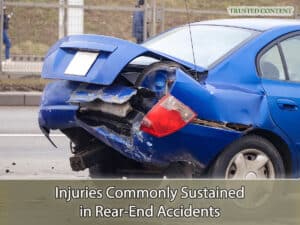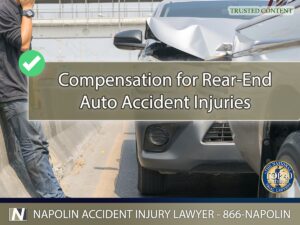Compensation for Rear-End Auto Accident Injuries in California – Technologist
Rear-end auto accidents are among the most common types of vehicular accidents in California, often resulting in significant injuries and financial strain for those involved. Understanding the legal framework and compensation options available in California is crucial for victims seeking justice and recovery.
Understanding Rear-End Collisions
Rear-end collisions occur when a vehicle is struck from behind by another vehicle, typically caused by factors such as distracted driving, sudden stops, and following too closely. California Vehicle Code Section 21703 establishes a duty for drivers to maintain a safe following distance, which often leads to the presumption of fault in rear-end collisions for the trailing driver if this duty is not met.
Legal Rights and Responsibilities After a Collision in California
Legal Rights and Responsibilities After a Collision in California
In the wake of a rear-end collision, understanding your legal rights and responsibilities is paramount for ensuring proper handling of the situation and protecting your interests:
- Reporting the Accident: California law requires that any auto accident involving injury or significant property damage be reported immediately to law enforcement. This official report is crucial as it serves as an unbiased record of the incident.
- Exchanging Information: It is mandatory to exchange contact and insurance information with the other driver. This includes full names, addresses, driver’s license numbers, and insurance policy details. This step is essential for facilitating the claims process.
- Seeking Medical Attention: Regardless of perceived injury severity, it is crucial to seek medical evaluation. Some injuries, such as whiplash or internal trauma, may not present immediate symptoms. Prompt medical documentation is vital for substantiating any later claims for compensation.
- Gathering Evidence: Collect as much evidence as possible at the accident scene. This includes taking photographs of the vehicles, the surrounding area, any visible injuries, and gathering names and contact information of witnesses. This evidence can be instrumental in supporting your claim.
- Legal Consultation: Consulting with a legal professional can provide insights into your rights and the best course of action. An attorney can also handle communications with insurance companies, helping to navigate the complexities of the claims process and ensuring that your rights are upheld.
Each of these steps plays a critical role in the aftermath of a rear-end collision, directly impacting the outcome of legal proceedings and the potential for recovering adequate compensation for damages and injuries sustained.
Claiming Compensation
California law allows victims of rear-end collisions to claim compensation for various damages incurred due to the accident. This includes medical expenses, lost wages, and compensation for pain and suffering. The process typically begins with filing a claim against the at-fault driver’s insurance policy, which might involve negotiations with insurance adjusters or, if necessary, pursuing a lawsuit to obtain rightful compensation.

Injuries Commonly Sustained in Rear-End Accidents
Injuries Commonly Sustained in Rear-End Accidents
Rear-end collisions often result in a range of injuries that can have varying degrees of severity and long-term effects. Here is a detailed look at some of the most common injuries:
- Whiplash: This neck injury results from the sudden back-and-forth motion of the head, typical in rear-end impacts. Whiplash can be difficult to diagnose because symptoms might not appear immediately and often lack visible signs. Long-term complications can include chronic pain and reduced mobility.
- Spinal Cord Injuries: The force of impact can cause damage to the spine ranging from minor disc herniation to severe spinal fractures. These injuries can be challenging to treat and may result in long-term disability, such as partial or complete paralysis.
- Concussions: A concussion is a mild traumatic brain injury that can occur when the brain is shaken inside the skull. The complications of proving a concussion include the subtlety of symptoms and the need for specialized imaging tests. Long-term effects can include cognitive impairment, memory loss, and emotional instability.
- Soft Tissue Injuries: These injuries affect the muscles, ligaments, and tendons and can be elusive on standard X-rays, which complicates both diagnosis and legal proof. Chronic pain and susceptibility to re-injury are common long-term issues.
Understanding these injuries and their potential complications is crucial for effectively managing the aftermath of a rear-end collision. Accurate diagnosis, immediate and ongoing medical treatment, and thorough documentation are essential to support legal claims for compensation due to these injuries.
Role of Evidence in Supporting Your Claim
Gathering and presenting the right evidence is crucial to establishing the validity of your claim after a rear-end collision. The evidence required typically includes:
- Medical records that document your injuries and their association with the accident.
- Witness statements that can corroborate your account of the events.
- Photographic or video evidence of the accident scene, including vehicle positioning, traffic signs, and road conditions.
- Police reports that provide an official account of the accident.
Choosing the Right Legal Representation
Selecting the right attorney is pivotal in navigating the complex legal landscape following a rear-end collision. An effective lawyer will not only guide you through the intricacies of the legal process but also advocate on your behalf to ensure you receive the compensation you deserve. Consider factors such as experience, client testimonials, and an attorney’s familiarity with local courts and legal practices when selecting your representative.
Preventive Measures to Avoid Future Accidents
While legal recourse is available after an accident, preventing such incidents is paramount. Adhering to safe driving practices is essential for reducing the risk of rear-end collisions. Drivers in southern California are encouraged to:
- Maintain a safe following distance, allowing adequate time to react.
- Avoid distractions such as mobile phones and other electronic devices while driving.
- Regularly check and maintain their vehicle’s brakes and tires to ensure optimal performance.
These preventive measures can significantly decrease the likelihood of accidents, contributing to safer roadways for everyone.

Compensation for Rear-End Auto Accident Injuries in California
Compensation for Rear-End Auto Accident Injuries in California
If you or someone you know has been involved in a rear-end collision in California, it is essential to act swiftly to protect your legal rights and secure the compensation you deserve. At Napolin Accident Injury Lawyer, we are committed to providing our clients with the comprehensive legal representation needed to navigate these challenging situations. With our extensive litigation experience and a deep understanding of California law, we are equipped to handle your case with the dedication and expertise it demands.
For a free consultation and to discuss your case with a seasoned legal professional near the Inland Empire, call us today at (866)-NAPOLIN. Our team is ready to help you assess your options and take the necessary steps toward recovery and justice. Let us help you secure the compensation you need to move forward from this challenging time.


